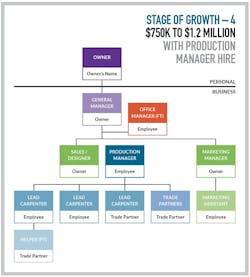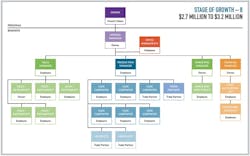Maximizing Profitability Across Stages of Growth
As a full-service design-build kitchen, bath, and interior remodeling franchise company, we are always looking at how we can improve our systems and processes for greater effectiveness, efficiency, and profitability.
The Business Challenge and Key Insight
Back in 2012, we were working on creating a Visual Process Flow Map of what happens with a lead, beginning with our sales process through our administration, production, and accounting system until the job has been successfully completed. When we started to analyze how different revenue levels of our locations across the country had differentneeds to scale profitably, we discovered something that puzzled us.
Up to that point we couldn’t fully figure out why one remodeling franchise doing more than $1 million a year in revenue, could pay themselves very well, and was left with a double-digit net profit, while another location with the exact same revenue struggled with cash flow and to breakeven. By digging into the data and org charts, we discovered one of the key reasons this was happening: The company that was always struggling at a million in revenue was overstaffed.
How and why does this happen? I have found there are several potential reasons:
1. Quickly throwing people at business challenges. Some company leaders/owners think staffing is the solution to solve problems in the business, versus applying systems.
2. Staffing heavy. Some keep hoping sales will increase to justify the number of staff; this can become vicious cycle and potential trap without the right experience and/or counsel.
3. Lacking knowledge, awareness, and time. Some are just blind to the reality they are overstaffed. They don’t know what they don’t know because they lack the time or business experience to do the deep dive to gain these kinds of insights.
Despite the business challenge we knew we had to solve, it was exciting that after 15 years of being re-branded as DreamMaker Bath & Kitchen, we had enough resources and time to dig into this.
The Solution to Our Challenge: The Stages of Growth Map
But what would we do with the insights we gained regarding revenue and staffing and their major effects on profitability?
In 2015, we took on a new project developing a Stages of Growth Map to show what it takes to get from a start-up with no sales to a multi-million-dollar company. As you could imagine, this was a tedious and time-consuming project. It was only possible because of the data we were able to gather from having enough locations, sales volume, years with a national business presence, and resources to embark on the study. We ultimately discovered and created a detailed “Stages of Growth Map,” outlining a clear path forward for our locations starting with zero revenue all the way to $5.2 million (with a vision toward an even much larger company).
Stages of Growth Map Insights
Let me share some specific insights we gained. For this example, I will focus on just one of the critical roles in a remodeling company and how that person’s responsibilities change as the business increases in annual revenue (or moves from one stage of growth to the next).
The role is an Office Manager, “OM”. Their job will change not only as revenue increases, but also as the company’s number of projects increase. With larger jobs, an OM can handle more sales volume, whereas an OM with smaller job averages cannot manage as much sales volume because they are dealing with a greater number of clients. Average job size isn’t necessarily good or bad, it is just understanding how they affect the dynamics of your business and staffing needs. The OM in our model has six key areas of responsibilities (see sidebar).
Now that you’ve become familiar with the OM responsibilities, allow me to share two examples on how their role evolves as the business grows.
Example 1: OM Role in Stage of Growth - 4
As a company starts growing into the middle of “Stage of Growth - 4” ($750K - $1.2 million in annual revenue with a job average of $25K), the first transition of responsibilities from the OM will be the marketing duties. The general manager will create a new part-time marketing position for their company. Why? Because the OM cannot provide excellence in service with his or her other responsibilities. Marketing or some other accountability will suffer.
You cannot afford for marketing to suffer, and now the need for maintaining lead flow is greater because of the higher sales volume. And you never know when the economy will shift, or a new competitor will come into play. We have learned the hard way you have to keep your marketing arm strong to weather the ups and downs of business. See the infographic that illustrates this transition from Stage of Growth - 3, to Stage of Growth – 4.
Example 2: OM Role in Stage of Growth - 8
If your annual revenue is about to break $2.7 million with an average job size of $25K, your OM can only handle the top three responsibilities out of the six. Why? Because with the volume of jobs being moved through the company, they will not have the capacity to keep up with all the details. Thus, your organizational chart and staff grows, as you now have brought on new hires for Accounting/HR and Purchasing. The key we have found is to know when to make these moves so that you are maximizing profitability and ensuring you are delivering excellent customer service to help drive repeat and referral business.
See the infographic of our “Stage of Growth - 8” organizational chart related to the example just explained.
Insight: the higher your average job size is, the lower number of salespeople you will need on staff (this example again is based on a $25K average job size).
It is my hope you picked up some nuggets to help on your road to operating a more stable, profitable business and a better quality of life. Should you have any questions on our stages of growth map, please send me an email, give me a call, or send me a connection and message on LinkedIn.




